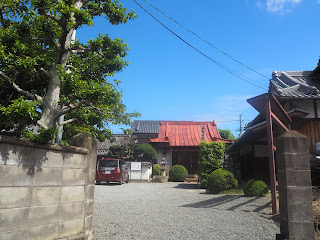Izumi 33 Kannon Pilgrimage in My Order ---in Coastal Central Izumi---
I visited the last 2 temples of the southerly leg of the Izumi 33 Kannon Pilgrimage. I first drove south along a so-called Osaka Prefectural Road #13, which is actually the the Osaka Prefectural Road #30.
#23 Kumeda-dera Temple
Since the dry season was long and water was scarce in Izumi Province, Emperor Obito (701-756) ordered the construction of an irrigation reservoir in the midland of the province. They built a 500-meter long embankment to dam up Haruki River. Kumeda Pond was completed after 14 years of construction from 725 to 738. He also ordered the founding of Kumeda-dera Temple in 738 to maintain and manage the reservoir.
Under the management of the temple, the embankment was repaired in 1289 and 1361. During the Warring States period, the maintenance and management was handed over to 12 irrigated villages (Ikejiri, Nakai, Midoro, Araki, Omachi, Haruki, Kamori, Yoshii, Komatsuricho, Tajime, Shimoikeda, and Nishioji Villages) and they formed Kumeda-ike Union. Kumeda Pond is still the largest pond in Osaka Prefecture.
During the Heian period (794-1185), Kumeda-dera Temple was under the control of Ichijo-in Temple, a branch temple of Kofuku-ji Temple in Nara. In the Jokyu War in 1221, samurai invaded and devastated the temple, but it was revived by Ando Rensho (1239-1329) under the Kamakura Shogunate.
After the collapse of the shogunate in 1333, some samurai threatened the temple’s territory. Under the Ashikaga Shogunate, it was designated as one of the Ankoku-ji Temples nationwide.
During the Warring States period, it was almost destroyed by fire in the Battle of Kumeda in March, 1562, in which Miyoshi Yoshikata (1527-1562) and Hatakeyama Takamasa (1527-1576) fought. When Oda Nobunaga attacked Ishiyama-Hongan-ji Temple from September 12th, 1570, to August 2nd, 1580, the temple was burned down. It was reconstructed in 1674 under the Tokugawa Shogunate. Repairs were carried out from 1751 to 1763, and its main hall was rebuilt in 1770.
Address: 934 Ikejiricho, Kishiwada, Osaka 596-0813
Phone: 072-445-0392
When I pilgrimed the westernmost leg of the Izumi 33 Kannon Pilgrimage, I actually tried to visit #27 Kisshoon-ji Temple. As I approached the temple, the street became narrower, and I finally gave up the call. I stopped depending on a navigation system, and checked the map carefully. Today, I parked my car in a nearby supermarket, and visited the temple on foot in the hot sun.
#27 Kisshoon-ji Temple
In the latter half of the 7th century, an eleven-faced Ekadasamukha statue emerged from the sea on a seashell. The statue on the shell went up the Mide River and arrived at Kaida, on the left bank of the river. Somehow, it crossed the river and was enshrined in Kisshoon-ji Temple on the right side of the river. It is enshrined in the Kannon-do Hall in the precincts of the temple.
Kisshoon-ji Temple has a Sri-mahadevi statue, which was mentioned in the Record of Miraculous Events in Japan, which was compiled by Monk Kyokai at the beginning of the 9th century.
Kisshoon-ji Temple exceptionally has no supporting families, but is supported by its individual believers.
The temple has a picture of the Sixteen Arhats, who are a group of legendary Arhats in Buddhism: Pindola Bharadvaja, Kanakavatsa, Kanaka Bharadvaja, Subinda, Nakula, Sribhadra, Mahakalika, Vajriputra, Gopaka,Panthaka, Rahula, Nagasena, Angaja, Vanavasin, Ajita, and Cudapanthaka. The picture was painted by Cho Densu (1352‐1431). Matsudaira Yasusada (1748-1807), the lord of the Hamada Domain in Iwami Province, took it away to Hamada Castle, and made it a folding screen. Then, the castle has tragedies, and he was troubled and annoyed everynight. He finally returned it to the temple.
Address: 703 Oji, Kaizuka, Osaka 597-0051
Phone: 072-423-1654











0 Comments:
Post a Comment
<< Home